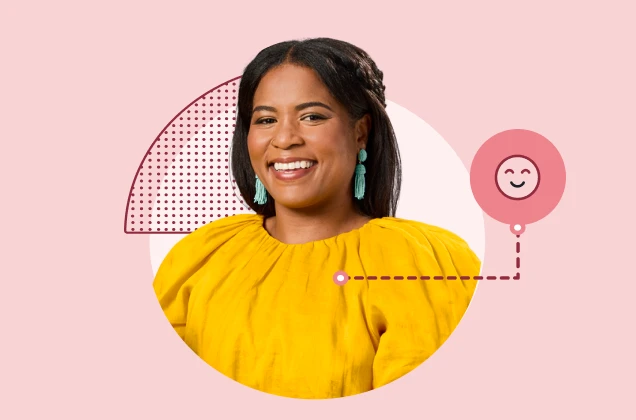Net Promoter® Score definition and formula
The Net Promoter Score explained by survey experts.
Working in marketing often means dealing with math, and the formulas can be mind-bogglingly complicated.
At what point in the purchase funnel do you see the greatest amount of conversions? How many clicks on your blog come from organic sources? And at what time do those clicks seem to peak?
Performing all of those calculations can make your head spin. The Net Promoter® Score methodology is refreshingly simple by comparison. Instead of asking hundreds of online survey questions and doing in-depth calculations, you’ll ask one powerful question (and a few refining ones).
Then, you’ll perform just one calculation. And you’ll get an industry standard score, ranging from -100 to +100. (Learn how to do the Net Promoter Score calculation here, use our NPS Calculator, or SurveyMonkey will calculate your NPS for you!)
Use NPS template
A quick Net Promoter Score definition
In a standard customer satisfaction survey example, you might ask consumers to give specific feedback on the products and services you provide. Questions like: “How quickly did the customer service team assist you?” can help you understand what consumers really think, and as a result, these questions are very valuable.
And although there are benefits to customer satisfaction versus NPS, these sample survey questions might not provide you with all of the detail you need to improve your business.
Why? Because people who are satisfied might still leave. That’s right. They might appreciate your speed and your products and your price. But, they might be just as willing to switch to another company if they get a better deal. In other words, they may like you, but they may like others more.
The Net Promoter Score Bain developed in 2003 is designed to ask something a lot different. Instead of asking if your customers are happy, you’re asking your customers if they’re promoters of your company. You’re trying to determine if your customers are willing to speak up and speak out about your brand. In essence, you’ll see how many of the people you work with right now are willing to be brand advocates.
The math you do at the end of the questionnaire will provide you with one number that will show you just how many of your consumers are willing to do that advocacy for you. Here’s how it works.
Net Promoter Score methodology
The NPS sample survey starts with one very basic but very powerful question: “How likely is it that you would recommend this company to a friend or colleague?”
We’re cutting right to the chase here, asking people straight up if they intend to work as advocates, or if they don’t really plan on spreading the good news about your products or services.
This isn’t a yes/no question, either. Participants are asked to grade their responses on a scale from 0 to 10, with low scores indicating a complete lack of willingness to work as an advocate, and 10 as a very high likelihood of working as an advocate.
The follow-up questions allow you to gather just a bit more data. Here, you’re asking open-ended survey questions that could help you to understand why people are willing to speak up for you, and what might need to change in order to make advocacy more likely. You might ask:
- What changes would this company have to make for you to give it a higher rating?
- What changes would this company have to make for you to give it an even higher rating?
- What does this company do really well?
The open-ended nature of this online poll will give you the data you need in order to push your products, services, or approach in a different direction. But, there’s one more thing you can do with these results in order to help your company. And yes, there is a little math involved.
Working with the numbers
In order to come up with a score, or percentage, of promoters, you’ll return to the answers consumers provided to your original question. Specifically, you’ll be looking at that little 0 to 10 grade they gave your company when asked if they’d promote it. Those grades allow you to segment your consumers into three groups:
- Detractors. These consumers give rankings in the 0 to 6 range. These are the consumers who aren’t willing to speak up for your company at all. In fact, they might be downright hostile to your company.
- Passives. Rankings in the 7 to 8 range put consumers in this category. They might buy from your company on a regular basis, but they might also be willing to switch to someone else, if something better comes along.
- Promoters. Scores of 9 to 10 turn consumers into promoters, and these are the customers all businesses want. They’re loyal, they’re active and they’re willing to share. What could be better?
Once you’ve segmented your respondents into groups, you’re ready for math. Thankfully, it’s pretty easy. A Net Promoter Score definition, in simplest terms, is the percentage of detractors subtracted from the percentage of promoters. You’ll do this by following this simple formula:
(Number of Promoters — Number of Detractors) / (Number of Respondents) x 100
That’s it!
This simple calculation will allow you to see how many consumers are fans of your company, willing to give it a shout out.
The power of the Net Promoter Score explained
The detail you get in follow-up questions will be a key part of the marketing changes you do and do not make for your company. That much is clear. But the numeric score you get after doing a little basic math is intensely powerful. It’s a benchmarkable number you can use, year after year, to track your progress. And, you can even use that number to compare your success with the success of your competitors.
And it all starts with one simple question. Click here to get started.
NPS®, Net Promoter® & Net Promoter® Score are registered trademarks of Satmetrix Systems, Inc., Bain & Company and Fred Reichheld.
Discover more resources

Brand Marketing Manager
Brand marketing managers can use this toolkit to understand their target audience, grow their brand and prove ROI.

Closed-ended questions: examples and how to use them
Closed-ended questions get specific, concise and targeted responses that allow us to conduct statistical analysis. Here’s everything you need to know.

What is data analysis and why is it important in market research?
Create data-informed marketing strategies that align with your target audience. Learn how to leverage your market research with thorough data analysis.

See SurveyMonkey solutions for consumer products and services
The consumer products and services industry, including CPG, travel and hospitality, relies on SurveyMonkey insights to shape what’s next.